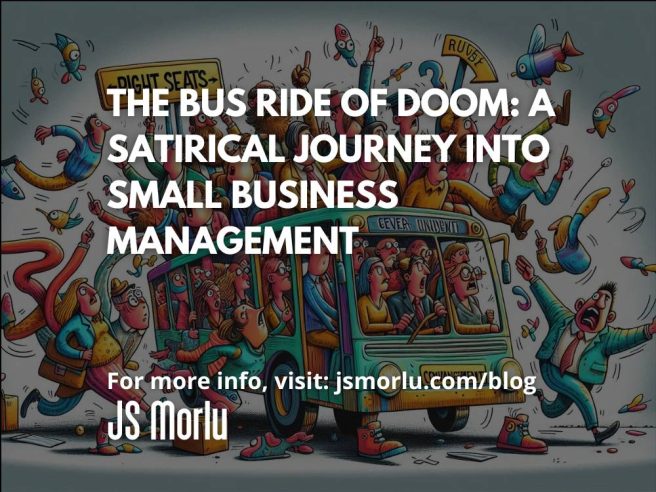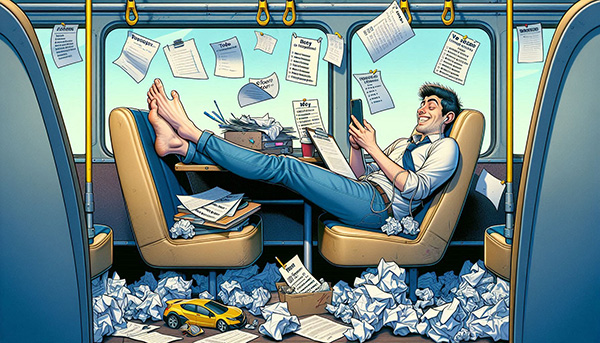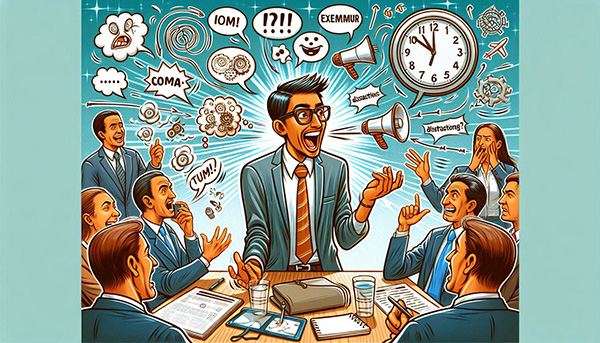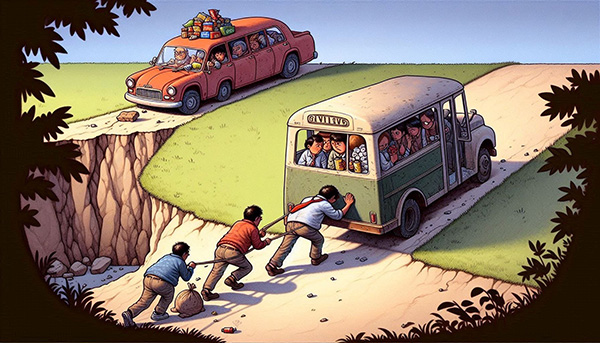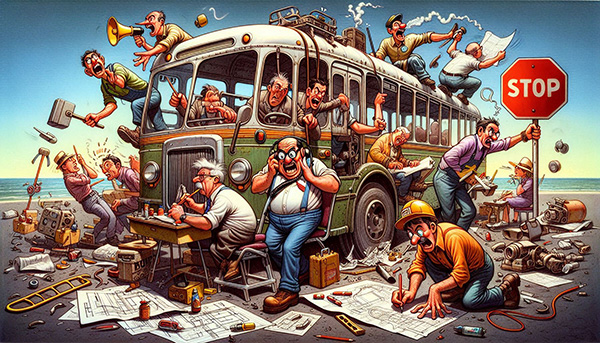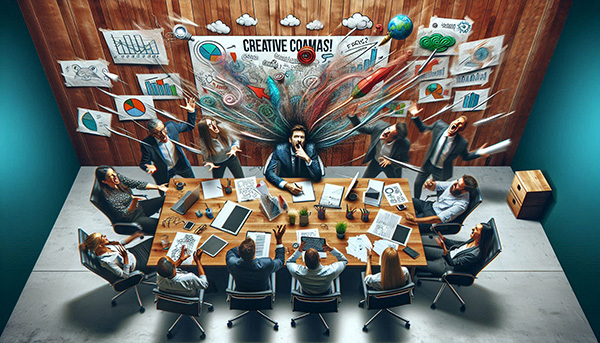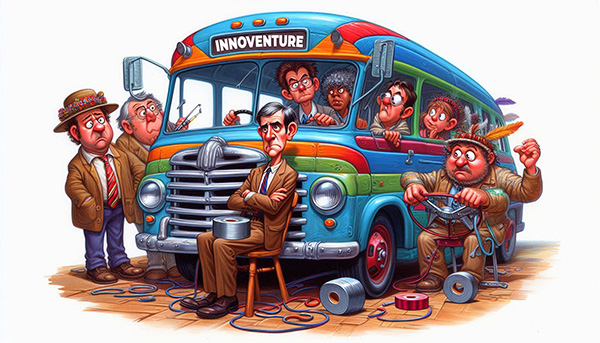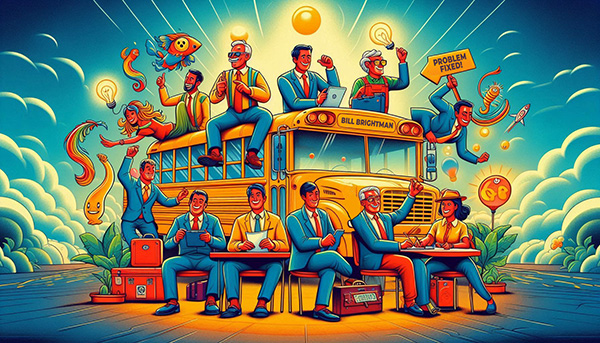Getting the Right People in the Right Seats (Or Trying to, Anyway)
By: John S. Morlu II, CPA
In a world where startups are sprouting up like gourmet coffee shops on every corner and where every third person on LinkedIn claims to be a “disruptor,” the idea of assembling the perfect team and placing them in just the right roles seems as straightforward as ordering a double-shot almond latte. You’d think that with all the self-proclaimed business savants out there, assembling a dream team would be a walk in the park. But seasoned entrepreneurs know the truth: the journey of team-building often resembles trying to herd cats onto a roller coaster in a rainstorm, complete with a soundtrack of screams, laughter, and the occasional panic-stricken shout.
Welcome aboard Innoventure, a fictional yet eerily relatable small business where management theories go to die and chaos reigns supreme. Here, the glossy promises of streamlined efficiency and harmonious teamwork are traded for the unpredictable antics of a crew that could turn even the most patient CEO’s hair gray. Forget the idealistic advice from textbooks; in this universe, the only guide is the wild reality of human behavior.
Join us as we take a hilarious dive into the quirky dynamics of team-building, introducing you to an ensemble of characters that embody every type of employee you’ve ever encountered—each more outrageous than the last. From the overzealous doer to the perpetual procrastinator, and the visionary whose ideas soar higher than the company budget can reach, these personalities collide in a comedic symphony of mismanagement and mayhem. Prepare for a wild ride filled with insights, laughter, and the stark truth that sometimes, the journey of finding the right people for the right seats is far more entertaining than any successful outcome could ever be. So buckle up, because this bus is bound for hilarity, and you won’t want to miss a moment of the ride!
Chapter 1: Meet the Cast of Characters
At Innoventure, a quirky small business specializing in artisanal light bulbs, things aren’t going exactly as planned. The founder, Bill Brightman, had read all the business books, attended every seminar, and even paid an exorbitant amount to hear a bald man in a black turtleneck declare, “Get the right people on the bus.” Bill took that advice to heart—perhaps a little too seriously.
So, he did what any self-respecting entrepreneur would do: he gathered a motley crew of characters who are as diverse as the light bulbs they sell. Buckle up, because here’s a closer look at the passengers of this chaotic ride:
1. Doer Doug
Title: Chief of Getting Things Done
Seat: Front row, but frequently sprawled across the aisle
Doer Doug is the kind of employee every company dreams of—until you realize he’s too much of a good thing. He’s a one-man army, always moving, always solving problems. Doug doesn’t just finish his own work; he swoops in to tackle everyone else’s, whether they ask for it or not. “Oh, you’re still working on that? Let me help!” he says, right before commandeering the project and presenting it as his own.
At one point, Doug tried to install the office coffee machine himself—an endeavor that ended with half the building rewired and a suspiciously cheerful barista in the corner. The bus has arrived, Doug, but did you have to build it from scratch? He’s the reason everyone else is taking extra shifts just to keep up with the chaos he inadvertently creates.
2. Visionary Vicky
Title: Chief Dreamer Officer
Seat: Literally hanging out the bus window
Vicky is the one who always knows exactly where the company should be going—but has zero clue how to get there. With wild ideas bubbling over like a fizzy drink, she’s the cheerleader of innovation who’s perpetually convinced that this time they’ll revolutionize the world. “Let’s launch a space program!” she exclaims, blissfully unaware that the company is still grappling with the intricacies of fixing its website.
Full of big ideas like “AI-powered light bulbs” or “Bluetooth-enabled glow-in-the-dark designs,” Vicky’s visions are grand. The problem? Nobody packed a map, and the fuel gauge is on empty. In fact, she’s like a GPS that insists you’re going to Timbuktu when you just wanted to reach the corner store for a bag of chips. Buckle up, because the ride might just take you on a wild detour through the Land of Overambition.
3. Procrastinator Pete
Title: Vice President of Infinite Tomorrow
Seat: Middle of the bus, feet on the seat in front, reading Reddit
Pete is the embodiment of every deadline nightmare. He has great ideas—good ones, even—but they never seem to escape the labyrinth of his “thinking about it” phase. “I’ll get to it tomorrow,” he promises, only for tomorrow to morph into next month, then next year. His bus seat is well-worn, not from constant travel, but from his dedication to sitting still while pondering the universe’s mysteries—like why lunch is always too far away.
Every day is a new beginning in Pete’s world, where to-do lists are sacred scrolls written on the back of napkins lost to the abyss of his desk drawer. He’s one of those employees who could single-handedly save the company with his brilliance… if only he could summon the motivation to actually do something about it.
4. Executioner Emily
Title: The Hammer
Seat: Driver’s seat, always hitting the gas
Emily is the efficiency guru every company secretly wishes for, but with a catch—she’s terrifyingly efficient. She’s the type of person who doesn’t ask “why”—she just asks “how fast can we get it done?” Problems? Solved. Obstacles? Bulldozed. But Emily has a tendency to forget that her fellow passengers might not appreciate the speed bumps along the way.
At one brainstorming session, she cut someone off mid-idea with a swift, “Is this actionable? No? Next!” Sure, she gets the bus moving, but half the passengers might fall out the back in the process. Emily’s motto could be “Ready, Fire, Aim!” and while her approach certainly keeps things moving, it doesn’t always make for a smooth ride.
5. Talkative Tammy
Title: Chief Chatterbox
Seat: Every seat, all the time, talking to whoever is closest
Tammy could talk the legs off a chair—if only she’d give them a chance to sit down. Her relentless enthusiasm for conversation often transforms meetings that should last an hour into marathon sessions that stretch to three, with everyone questioning their life choices. When she starts sharing stories—like how she got her dog, Spot, to wear a sweater last Christmas—you can almost hear productivity hitting a brick wall.
In fact, during one particularly animated pitch meeting, Tammy single-handedly talked an investor out of funding the project by reminiscing about her collection of rare houseplants. You know, the ones that supposedly had “superpowers.” If you ever need to stall a discussion, just let Tammy take the floor—who needs silence when you have endless anecdotes?
6. Pretender Paul
Title: Director of Smoke and Mirrors
Seat: A VIP seat that no one remembers assigning
Paul is the quintessential corporate chameleon, master of appearances but lacking any substantial contributions. He looks the part, talks the talk, but when it’s time to walk the walk, he’s mysteriously absent. His LinkedIn profile boasts about transforming companies and revolutionizing industries, but when asked what he does at Innoventure, you get a collective shrug from the team.
Paul can spend hours in “strategic meetings” that nobody else is invited to, emerging with vague proclamations of victory that amount to little more than corporate fluff. Is he even on the bus? No one can be sure. But as long as he’s in the room, everyone’s left guessing what exactly he’s doing—and why they can’t find the “strategic outcomes” he always promises.
7. Giver Grace
Title: The Martyr
Seat: Standing room only, because she gave up her seat for someone else
Grace is the ultimate team player, the kind of employee who stays late, picks up the slack, and ensures everyone else is okay—even at her own expense. She’s always there to lend a helping hand, but in doing so, she often burns out while trying to carry the entire company on her back. When the bus breaks down, Grace will be the one pushing it uphill while everyone else is sitting inside, bickering over who’s to blame for the flat tire.
It’s a classic case of “too much of a good thing.” Grace’s selflessness is commendable, but the rest of the crew might want to check on her before she breaks down herself. After all, if the bus isn’t running, who will be there to fix it?
8. Taker Tim
Title: Chief Moocher
Seat: Whatever seat has the best snacks
Tim is that employee who does just enough to get by but never more. He’s the guy who takes credit for the team’s success while conveniently disappearing when it’s time to face failure. At office lunches, he’s the one who “forgets” his wallet, relying on Grace’s generosity to cover him.
On the bus, he’s the one sneaking snacks while Grace is sweating through her shirt trying to fix the engine. Tim’s motto? “Work smarter, not harder”—which, in his case, translates to “let someone else do it.” He’s like the kid in class who figures out that if he sits quietly, he can coast through without ever raising a hand.
And there you have it—the colorful cast of characters at Innoventure, each bringing their own brand of chaos to the proverbial bus ride. Together, they create a delightful mess that leaves you questioning how on Earth any light bulbs ever get sold. But therein lies the humor and insight: in the unpredictable world of small business, it’s not just about getting the right people on the bus; it’s about surviving the journey with all its wild detours, laugh-out-loud moments, and the occasional existential crisis.
Chapter 2: The Wild Ride of Company Culture
So, what happens when you throw all these personalities on a bus and tell them to drive the company to success? Absolute mayhem, that’s what. Picture this: a gaggle of well-meaning misfits trying to navigate the bumpy road of entrepreneurship, with each character contributing to a chaotic symphony of dysfunction.
The management gurus said, “Get the right people in the right seats,” but let’s face it—sometimes the seats are broken, and half the people don’t even know where they’re supposed to sit. In this wild ride, the bus isn’t just a mode of transport; it’s a microcosm of every quirky company culture ever invented.
As Doug is earnestly trying to fix the bus engine (which isn’t even broken), he’s convinced that if he just applies enough elbow grease, everything will start running smoothly. “If it’s not working, I’ll make it work!” he proclaims, wielding a wrench like it’s a magic wand. Little does he know, the bus is perfectly fine, but Doug’s obsession with DIY solutions could lead to a new brand of artisanal bus mechanics.
Meanwhile, Emily is in the driver’s seat, leaning on the horn like it’s a trusted friend. “Hurry up or get out of the way!” she yells at Doug, who is now tangled in wires and duct tape, convinced he’s inventing the next best thing in automotive engineering. What he’s really doing is causing an existential crisis for the bus itself—there’s a point at which enthusiasm turns into confusion, and we’ve officially crossed that line.
Pete is still staring at a map of “potential routes,” blissfully unaware that no one asked for his input. “We could go this way,” he suggests, tapping his finger on a path that leads straight into a lake. “Or maybe this way?” he muses, pointing to a road marked “Do Not Enter.” The rest of the team exchanges glances, half-hoping for a GPS miracle that will guide them out of Pete’s brainstorming session.
Vicky, ever the visionary, is sketching plans for a new, solar-powered bus that no one asked for—mainly because everyone is still trying to figure out how to keep the existing one from falling apart. “Imagine it!” she exclaims, waving her crayon-drawn blueprints like they’re a secret treasure map. “We’ll revolutionize transportation and reduce our carbon footprint! It’ll be amazing!” The only problem? The current bus is emitting more existential dread than carbon emissions, and the team can’t quite figure out how to change gears, let alone launch a space-age shuttle.
And then there’s Tammy, narrating the entire situation like a live commentator at a chaotic sporting event. “And in the left corner, we have Doug the DIY Master, attempting to fix something that’s not broken! And in the right corner, Emily the Efficiency Enforcer, ready to blow a gasket! This should be entertaining!” Her commentary is both hilarious and infuriating, punctuating each chaotic moment with exclamations that could fuel an entire sitcom series. If you didn’t know better, you’d think she was hoping for a reality TV contract with all the drama unfolding.
In the back of the bus, Paul is busy pitching the idea of a “bus rebranding” to no one in particular, complete with PowerPoint slides and a strategically placed flip chart. “What if we made this bus look like a luxury vehicle?” he suggests, clearly envisioning a high-end reupholstering that would be both impractical and wildly unnecessary. No one really knows what he’s doing, but he’s so wrapped up in his own presentation that he doesn’t realize the only thing being rebranded is the collective eye-roll from the rest of the team.
Grace is the unsung hero running around, ensuring everyone has snacks and the necessary hydration for this rollercoaster ride. “Anyone want some kale chips?” she asks, offering a platter that nobody seems particularly excited about. “No? How about some organic gummy bears?” It’s her way of spreading joy amidst the chaos, and she’s convinced that sugar will help fuel some brilliant ideas. Meanwhile, Tim is, of course, just eating the snacks, leaving the rest of the team in a snack-related panic. “I thought we had more granola bars!” Grace exclaims, aghast, as Tim nonchalantly pops another in his mouth, blissfully unaware of the snack shortage crisis he’s causing.
As the bus careens down the road, with ideas flying around like confetti, it’s clear that finding the right people isn’t just about getting them in the right seats—it’s about learning to navigate the wild ride of company culture. Each character brings their unique flair, and while their antics may drive Bill Brightman to the brink of insanity, they also create a tapestry of creativity that no textbook could ever capture.
In the end, the real question isn’t whether they’ll reach their destination—it’s whether they’ll manage to enjoy the ride along the way. And if they can survive this chaotic journey without losing too many snacks, perhaps there’s hope for Innoventure after all. Because in the grand adventure of small business, every wild ride is a lesson, and every character, no matter how quirky, plays a vital role in the story.
Chapter 3: Leadership’s Best Intentions, Worst Realities
Bill Brightman, the beleaguered founder of Innoventure, sat at his cluttered desk, staring at the chaos unfolding before him like a scene from a particularly wild circus. “This is what business success looks like?” he muttered, barely able to comprehend the disarray. He recalled the countless hours spent listening to business gurus, motivational speakers, and consultants—each one making success sound as simple as ordering a “triple venti soy caramel macchiato with extra foam.”
“Get the right people on the bus!” they said. “Leverage your talent!” “Culture eats strategy for breakfast!” They had all these shiny catchphrases, but no one ever mentioned the hangover that comes after the breakfast buffet of good intentions.
Bill had been confident he had this whole thing figured out. But as he watched Doug attempting to rewire the coffee machine—again—while Emily drove the metaphorical bus with the pedal to the metal and Vicky hung out the window brainstorming new solar-powered ideas, he quickly realized that finding the right people wasn’t enough. You have to figure out what to do with them once they’re on board.
The problem with all these management maxims is that they don’t account for one crucial fact: People are weird. They don’t fit neatly into boxes, roles, or frameworks, no matter how well you label them. The books say to find the “doers” and the “visionaries” and put them in the right spots, but what happens when your doer is a control freak and your visionary can’t keep track of their lunch, let alone a five-year strategic plan?
“Okay, team!” Bill tried to muster his enthusiasm as he called a meeting, hoping against hope that some semblance of order could emerge. “Let’s gather around and discuss our next steps.”
Doug, still tangled in cords from his last misguided project, raised his hand. “How about we fix the engine?”
“No, Doug,” Bill sighed, “the engine is fine. We need to focus on—”
“Let’s revolutionize light bulbs!” Vicky shouted from her perch by the window, holding a half-eaten muffin like it was a magic wand. “Imagine bulbs that change color based on your mood! We could call it ‘EmotiBulb’!”
“Right, because nothing says ‘successful company’ like light bulbs that glow sad when you’re having a bad day,” Pete chimed in, flipping through a dog-eared notebook of half-baked ideas. “Or how about we create a light bulb that doubles as a pet rock? Less maintenance, right?”
Emily rolled her eyes so hard it looked like they might get stuck. “We need to focus on sales, people! Let’s not get sidetracked by mood lighting or pet rocks. What’s actionable?”
Tammy seized the moment, her eyes sparkling with excitement. “Speaking of actionable, did I tell you all about my dog, Spot, and how he’s learning to fetch different colored balls? It’s a metaphor for teamwork!”
Bill’s head was spinning. “Tammy, that’s… not at all what we’re talking about.”
“Maybe it could be part of a team-building exercise!” she insisted, her chatter drowning out any semblance of productive conversation.
“Let’s keep our eyes on the prize!” Bill urged, trying to rally the troops. “What’s our sales strategy for the next quarter?”
“Sales strategy?” Grace perked up, finally taking a break from her snack management duties. “I’ve got an idea! What if we make a calendar featuring our artisanal light bulbs, each with a motivational quote? Everyone loves those!”
Paul, who had been quietly nodding along, suddenly perked up as if struck by inspiration. “Yes! And we can position ourselves as ‘thought leaders’ in light bulb motivational quotes. I can start a blog about it!”
Bill’s heart sank. “So we’re pivoting from making light bulbs to creating inspirational memes?”
“Why not?” Paul grinned. “It’s the 21st century! People need motivation! And who wouldn’t want to buy a light bulb that inspires them? We could use emojis!”
Just as he thought things couldn’t get more absurd, Tim ambled in, dragging a half-empty snack tray behind him. “I think we should just do what feels good, you know? Like, who’s up for a ‘bring your dog to work’ day? That’ll boost morale!”
As the brainstorming session spiraled into a cacophony of wildly impractical ideas—dogs, mood lighting, and motivational quotes—Bill realized he was no longer steering this bus. He was merely holding on for dear life as it careened down the hill of absurdity.
The meeting, which had started with the hope of establishing a clear direction, ended up with each member lost in their own peculiar universe, contributing to a whirlwind of confusion and chaos. It dawned on Bill that the team was full of passion, creativity, and absolutely zero alignment.
“Okay, team,” Bill finally said, raising his hands in defeat. “Let’s table the dog-inspired motivational calendars for now. How about we start with a very basic step—understanding what our roles actually are? Who does what?”
Cue the silence. Everyone looked around, suddenly unsure of their own job descriptions. “I’m the Chief of Getting Things Done!” Doug proudly declared, but he had just spent the last hour trying to fix something that wasn’t broken.
“I’m the Chief Dreamer!” Vicky shouted, as if the title alone could excuse her lack of practical contributions.
“And I’m the Vice President of Infinite Tomorrow,” Pete said, scratching his head, “but that’s just another way of saying ‘professional procrastinator.’”
Bill rubbed his temples. “How can we possibly move forward when nobody seems to know what they’re doing?”
In that moment, he realized that perhaps the most important lesson wasn’t about fitting people into perfect roles but about embracing their quirks and learning how to work together in a way that acknowledged their collective chaos. Maybe the key to success was finding a way to harness that weirdness rather than trying to fit everyone into neat little boxes.
“Alright,” he said with a half-smile. “How about we embrace our chaos and come up with some creative ways to leverage our talents? Let’s make this wild ride a little more fun. No more dog-themed motivational memes—at least for today.”
With a hesitant cheer from the team, Bill finally felt a spark of hope. Maybe, just maybe, they could make this chaotic bus journey into something worthwhile—after all, it was all about the ride, wasn’t it?
Chapter 4: The “Bus Ride” Reality Check
In theory, building a great team sounds easy: just put the right people in the right seats, give them clear directions, and cruise your way to success. But in reality, it’s more like trying to drive a bus filled with a cast of characters who are as unpredictable as a cat in a bathtub. The journey is anything but smooth, and if you’re Bill Brightman, you quickly realize there’s no GPS for managing the chaos that is your team.
It’s not that Bill didn’t try. He had the bus (Innoventure, of course), he had the people (a mix of visionaries, doers, snack eaters, and distraction makers), and he had the destination (Successville, population: probably not us). But no one warned him about the constant breakdowns, detours, and passenger meltdowns along the way.
Tim, for example. You remember Tim, right? The guy whose most meaningful contribution to the team was keeping the snack cupboard mysteriously empty while never actually doing anything remotely useful. In theory, Tim was the “ideas guy,” but his biggest idea so far had been rebranding their light bulb company as “The Snack Company”—an idea he only pitched because it involved more snacks. Tim, Bill finally realized, might not be the right person for any seat on the bus. In fact, Tim was the guy who probably needed to be dropped off at the next stop, preferably with a coupon for free snacks elsewhere.
Then there was Doug. Oh, Doug. A talented fixer with an obsession for fixing things that didn’t need fixing. Doug could spot a problem from a mile away—whether or not it actually existed. Bill would catch Doug in the middle of a 4-hour deep dive into “bus engine repair” only to remind him, “Doug, this isn’t a real bus. It’s a metaphor. And even if it was real, the engine is fine. Maybe work on our website instead?” Doug’s response was always the same, “Sure thing, boss. But just in case, I’m going to upgrade the metaphorical engine to a V8 turbo.”
And then, of course, there was Pete. Sweet, procrastinating Pete. He was the map guy—the one who was supposed to plot the course and make sure the bus stayed on track. Unfortunately, Pete had a habit of staring at maps for hours without ever actually choosing a route. His desk was filled with half-finished plans, route options, and “what-if” scenarios that had yet to materialize into anything actionable. “Pete,” Bill would ask during their weekly meetings, “where are we going?” Pete would glance up, blink a few times, and say, “We’re going somewhere great. Just give me a bit more time to review these maps.” Bill had long since stopped asking which map Pete was actually looking at.
And who could forget Vicky? Vicky, with her wild, boundless energy, was constantly dreaming up the next big thing. Last week it was solar-powered light bulbs. This week, she was pitching a new idea for a bus that ran on… happiness. Yes, happiness. “Imagine a world,” she’d begin passionately, “where our company doesn’t just sell light bulbs. We sell joy. We create light that changes based on your mood—no switches, no dials. Just pure, emotional lighting.” Bill didn’t have the heart to tell her that the world might not be ready for “emotional lighting,” but he appreciated her creativity—when it wasn’t derailing the actual business.
Emily, on the other hand, was as sharp as they come. She could execute like nobody’s business, but her aggressive style was often a little… intimidating for the rest of the team. She’d bark orders like a drill sergeant, whipping everyone into action, but the chaos she left in her wake was enough to send more than one team member hiding in the break room. Bill had to balance letting Emily lead without having the team stage a quiet rebellion under the fluorescent lights. He was pretty sure that once, during a particularly intense meeting, Tim had pretended to choke on a granola bar just to get out of the room.
As Bill looked around at this motley crew, he couldn’t help but chuckle. Here he was, trying to steer a bus full of unpredictable personalities toward a common goal. The management gurus made it sound so simple: “Just get the right people on board, and everything will work out!” But they failed to mention that sometimes the bus breaks down. Sometimes your passengers are more interested in snacks than the destination. And sometimes, even with the right people, the whole thing feels like a poorly orchestrated improv performance.
What Bill had learned—perhaps the hardest way possible—is that managing people isn’t about perfect formulas or tidy solutions. It’s about rolling with the punches and figuring out how to harness the strengths (and weird quirks) of each team member without driving yourself—or the bus—off a cliff.
Take Doug’s overzealous fixing, for instance. Sure, it was a bit over the top, but when something really did break (like the website mysteriously crashing after Tim’s ill-fated attempt to “optimize” it), Doug was the hero of the day. Pete’s procrastination could be frustrating, but every now and then, his endless tinkering with maps would reveal a hidden opportunity that no one else had considered. And as for Vicky’s wild ideas? Well, once in a while, one of her off-the-wall concepts sparked something brilliant.
Even Emily, with her steamroller style, was a vital part of the equation. Without her, nothing would ever get done, and without Grace running around ensuring everyone was fed and watered, Bill feared half the team might wander off in search of sustenance, never to return.
The reality check Bill needed wasn’t about finding the right people and putting them in the right seats—it was about figuring out how to drive the bus with a crew that didn’t always follow the rules of the road. It was about learning when to let them roam free and when to pull them back. And, most importantly, it was about embracing the beautiful, chaotic mess that is human nature.
As he sat back, watching Tim sneak another cookie from the snack tray while Doug recalibrated his metaphorical engine for the hundredth time, Bill couldn’t help but grin. Sure, the bus wasn’t running perfectly, but it was still moving. And maybe, just maybe, the key wasn’t in controlling the ride—it was in enjoying it.
“Alright, team,” Bill called out, a twinkle in his eye, “let’s get this bus rolling. Snacks for everyone, and Vicky, maybe hold off on the happiness-powered bus… for now.”
And with that, the wild ride continued—chaos, unpredictability, and all.
Chapter 5: The Final Stretch – Learning to Love the Chaos
As the bus careened down the highway of business, Bill found himself less worried about the cracks in the windshield and more fascinated by the sheer unpredictability of the ride. Sure, there were potholes and detours, but at some point, Bill had stopped gripping the steering wheel so tightly. He had learned something: running a company wasn’t about control, it was about balance, flexibility, and, most importantly, humor. And now, here he was, laughing as Tim—yes, Tim—pitched another ridiculous idea involving snacks, this time with a PowerPoint.
It was during one of these surreal moments—half-listening to Tim while Vicky sketched yet another reinvention of the bus—that Bill realized something profound. Success wasn’t about reaching some perfect destination where the team ran like a well-oiled machine. No, the real success was learning how to embrace the mess, the personalities, and the quirks that made his team unique. Because as chaotic as they were, this ragtag group of misfits was his greatest asset.
Let’s Review the Characters:
- Doug: The obsessive fixer. When he wasn’t trying to repair things that didn’t need fixing, Doug was the guy you needed in a crisis. He may have spent 90% of his time tinkering with metaphorical engines, but that last 10%? Pure gold. Bill realized Doug didn’t need more supervision—he needed space to tinker and, when needed, be called into action to save the day.
- Pete: The procrastinator with a purpose. Sure, Pete could stare at a map for hours and get lost in planning details, but once Bill gave him clear deadlines and check-ins, Pete’s endless route-planning became one of the company’s secret weapons. Bill discovered that Pete’s deep analysis paid off when he had the time to dive in, but with the right push, he could also make decisions faster.
- Emily: The human bulldozer. Emily’s no-nonsense, drill-sergeant approach might have scared half the team, but Bill knew her leadership was indispensable. Instead of reigning her in, he encouraged Emily to refine her management style. Emily learned to delegate more and started fostering collaboration, turning her intimidating efficiency into something the team actually respected (mostly).
- Vicky: The visionary who saw the future… and sometimes forgot about the present. Vicky’s ideas were often too wild for prime time, but Bill had come to see her as the company’s secret sauce. She wasn’t just generating off-the-wall concepts; she was the spark that kept the company from becoming stale. Bill learned to give her a sandbox to play in and occasionally let one of her wild ideas take flight—because sometimes, against all odds, Vicky’s crazy ideas worked.
- Tim: The snack man with big dreams. Bill had long considered Tim to be more of a professional snacker than an asset to the team, but after numerous “bus rebranding” PowerPoints, Bill discovered Tim’s secret talent: he was great at marketing (snacks and ideas). Tim might not have been the most reliable in a crisis, but when it came to rebranding or launching a new product, he had an undeniable knack for understanding the consumer. Bill gave Tim more focused tasks, leveraging his weird genius for ideas without letting him derail the core business with too many tangents.
- Grace: The glue holding everything together. Grace had always been the quiet powerhouse, making sure everyone was fed, watered, and cared for. But Bill realized she was more than that—Grace was the team’s emotional anchor. In a sea of chaos, she kept morale up and ensured that even in their wildest moments, the team didn’t implode. Bill started recognizing Grace’s role as critical to the team’s overall success.
The Big Takeaway:
As Bill reflected on his journey with the team, it became clear that no management book could ever prepare you for this kind of leadership. The gurus had told him to get the right people on the bus and everything would work out, but what they didn’t mention was that the bus would take on a life of its own, and no map could account for the wild, unpredictable realities of human nature.
The secret wasn’t in forcing everyone into neatly defined roles or micromanaging their every move. The secret was in letting go of the illusion of control and learning to lead the team they way they were—not as some perfect version imagined by the consultants, but as the wild, weird, wonderful team they actually were.
Conclusion: The Bus Keeps Rolling
Bill looked out at his team, now a mix of focused chaos, creative brainstorming, and the occasional snack break, and realized that this was it—this was success. Not the smooth, predictable ride he had imagined, but a bumpy, messy, often hilarious journey with people who, in their own strange ways, made the bus go.
Sometimes, the engine still sputtered. Sometimes, Tim still ate too many snacks. But at the end of the day, Bill had learned to embrace the chaos, the personalities, and the unpredictability. He had learned that leading a team was less about reaching some idealized version of success and more about enjoying the ride—missteps, detours, and all.
As Bill stood at the front of the metaphorical bus, hands lightly on the steering wheel, he called out to his team, “Alright, everyone. We’ve come this far. Where to next?”
Pete looked up from his map and shrugged. “Somewhere interesting, I’m sure.”
Vicky chimed in, “How about we power the bus with wind turbines this time?”
Doug muttered, “Better check the tires first.”
And Tim? Well, Tim just grinned from the back, holding up a fresh batch of snacks. “I’m ready for anything.”
And with that, the bus—fueled by chaos, creativity, and a whole lot of snacks—rolled on. Bill smiled, realizing that he might never know exactly where they were headed, but he was enjoying every wild moment of the ride.
After all, that’s what running a company is all about: embracing the unknown, laughing through the chaos, and always making sure there’s enough room for a snack break.
Author: John S. Morlu II, CPA is the CEO and Chief Strategist of JS Morlu, leads a globally recognized public accounting and management consultancy firm. Under his visionary leadership, JS Morlu has become a pioneer in developing cutting-edge technologies across B2B, B2C, P2P, and B2G verticals. The firm’s groundbreaking innovations include AI-powered reconciliation software (ReckSoft.com) and advanced cloud accounting solutions (FinovatePro.com), setting new industry standards for efficiency, accuracy, and technological excellence.
JS Morlu LLC is a top-tier accounting firm based in Woodbridge, Virginia, with a team of highly experienced and qualified CPAs and business advisors. We are dedicated to providing comprehensive accounting, tax, and business advisory services to clients throughout the Washington, D.C. Metro Area and the surrounding regions. With over a decade of experience, we have cultivated a deep understanding of our clients’ needs and aspirations. We recognize that our clients seek more than just value-added accounting services; they seek a trusted partner who can guide them towards achieving their business goals and personal financial well-being.
Talk to us || What our clients says about us

